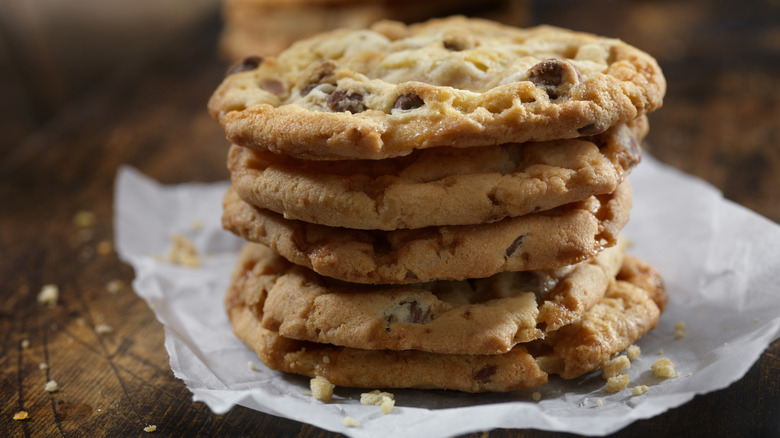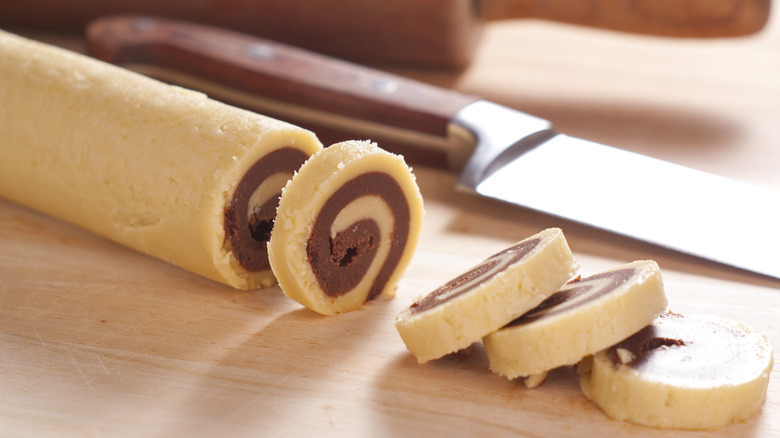Make Cookies With Frozen Dough And You Won't Go Back
Fresh-out-of-the-oven cookies are one of life's simplest pleasures, so why aren't we making ourselves happy more often? Yes, baking from scratch can be messy and time-consuming, but you don't need to pull out the stand mixer each time you crave a warm chocolate chip cookie with a scoop of vanilla ice cream on top (oh my).
Rather than relying on store-bought tubes or processed pull-apart cookie dough, prepare a batch of cookies from scratch and freeze a portion of the dough to experience the aroma and texture of homemade cookies sometime in the future. Since cookies really should be baked directly from the freezer, there's no need to thaw. Just preheat the oven and wait about ten minutes for nirvana.
For chewy on the inside and crispy along the edges, place frozen cookie dough on a parchment-lined cookie sheet and bake the cookies according to the recipe. Make sure to account for spreading and adequately space the dough, often two inches apart. Since food gradually cooks from the perimeter to the core, the frozen dough keeps the center soft and gooey as the bottom and edges turn golden brown — think molten lava cakes.
If you prefer a crispier cookie with a snap, place the frozen cookie dough in an oven 15 degrees lower than the recipe indicates and bake the cookies a few minutes longer. Whether it's the winter holidays or a slow summer night, now is the perfect time to get a jumpstart on cookie-making by freezing some dough.
How to properly freeze cookie dough
Most cookie dough freezes well, but drop cookies like oatmeal raisin, chocolate chip, and chewy molasses deliver hot cookies the fastest. If properly stored, cookie dough can be frozen for up to four months, incentivizing home bakers to quadruple batches now to enjoy freshly baked cookies further down the line.
Prepare the cookie dough according to the recipe and portion evenly-sized dough balls on a parchment-lined baking sheet. If you have a kitchen scale, you can weigh the balls to keep them uniform, but an ice cream scoop is quicker. Each level scoop will ensure the cookies are the same diameter and shape, and will thus bake at the same rate.
A #16 scoop is a common size and portions about five tablespoons of dough for a medium-sized cookie. Use a #60 scoop for mini cookies holding one tablespoon of dough. Although the dough balls shouldn't touch, they don't need to be spaced apart like when baking.
Place the sheet in the freezer uncovered, and allow the dough balls to freeze solid. This can be done overnight. Once frozen, you can transfer the balls to a resealable zipper bag and squeeze all the air out. Don't forget to label the bag with the date and name of the cookie since they all look similar once frozen. Since the dough balls were individually frozen, you can make a cookie or two anytime you really need one — a delicious, crispy, chewy-in-the-middle cookie.
What types of cookies freeze the best?
Aside from drop cookies, slice-and-bake cookies like pinwheels, checkerboard, and shortbread, which require chilling before baking, can be successfully frozen too. Place the raw dough in the center of parchment paper, wax paper, or plastic wrap and form it into a uniform log, ensuring the middle and ends are the same width.
Roll the parchment around the dough and twist the edges sealed. To maintain the cookie's round shape, cut an empty paper towel cardboard tube lengthwise and place it around the wrapped dough like armor. This will prevent the soft dough from flattening on one side until it freezes solid.
Alternatively, if you don't have a cardboard tube, rotate the dough every 15 minutes until frozen, or embrace the angles and bake square cookies. Since slice-and-bake cookie dough tends to be crumbly directly from the freezer, allow the log to rest briefly before slicing. However, the entire log should be sliced and baked once thawed since it can't be refrozen.
Cut-out cookies like gingerbread and sugar cookie dough are great to freeze since these recipes are multistep. Place the dough on a sheet of plastic wrap and form an even, flat disk. Wrap the dough in plastic wrap and place it in a resealable freezer bag. Freeze it on a baking sheet until solid to ensure it freezes flat. If you have prepared multiple batches, it's best to divide the dough into several disks, making it easier to roll and cut.



